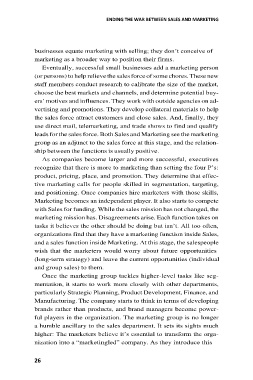Page 36 - HBR's 10 Must Reads - On Sales
P. 36
ENDING THE WAR BETWEEN SALES AND MARKETING
businesses equate marketing with selling; they don’t conceive of
marketing as a broader way to position their firms.
Eventually, successful small businesses add a marketing person
(or persons) to help relieve the sales force of some chores. These new
staff members conduct research to calibrate the size of the market,
choose the best markets and channels, and determine potential buy-
ers’ motives and influences. They work with outside agencies on ad-
vertising and promotions. They develop collateral materials to help
the sales force attract customers and close sales. And, finally, they
use direct mail, telemarketing, and trade shows to find and qualify
leads for the sales force. Both Sales and Marketing see the marketing
group as an adjunct to the sales force at this stage, and the relation-
ship between the functions is usually positive.
As companies become larger and more successful, executives
recognize that there is more to marketing than setting the four P’s:
product, pricing, place, and promotion. They determine that effec-
tive marketing calls for people skilled in segmentation, targeting,
and positioning. Once companies hire marketers with those skills,
Marketing becomes an independent player. It also starts to compete
with Sales for funding. While the sales mission has not changed, the
marketing mission has. Disagreements arise. Each function takes on
tasks it believes the other should be doing but isn’t. All too often,
organizations find that they have a marketing function inside Sales,
and a sales function inside Marketing. At this stage, the salespeople
wish that the marketers would worry about future opportunities
(long-term strategy) and leave the current opportunities (individual
and group sales) to them.
Once the marketing group tackles higher-level tasks like seg-
mentation, it starts to work more closely with other departments,
particularly Strategic Planning, Product Development, Finance, and
Manufacturing. The company starts to think in terms of developing
brands rather than products, and brand managers become power-
ful players in the organization. The marketing group is no longer
a humble ancillary to the sales department. It sets its sights much
higher: The marketers believe it’s essential to transform the orga-
nization into a “marketingled” company. As they introduce this
26

